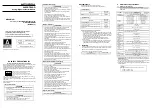
Network Operation and Remote Control
R&S
®
SMA100B
284
User Manual 1178.3834.02 ─ 03
1. To return from "Remote" state to manual state, perform one of the following:
● On the controller, use the command
>L
Note:
If
&NREN
has been set before
>L
is locked. Use
>R
instead.
● In the status bar, select the "Remote" icon.
● On the front panel, press the LOCAL key.
● In the block diagram, select "Context sensitive menu > Key Emulation > Local"
2. To return from "Remote LLO" state to manual or to "Remote" state, perform one of
the following:
Note:
In the local lockout state, the command
>L
and the LOCAL key are
locked. You can unlock this state only via remote control.
● On the controller, use the command
&LOCS
.
This command switches directly to manual operation.
● Send the command
&REMS
.
This command changes the remote control state from "Remote LLO" to
"Remote".
● Use the Visual Basic command
CALL IBLOC (generator%)
.
The command switches directly to manual operation.
● VISA function
viGpibControlREN()
This function switches directly to manual operation.
11.11 Automating Tasks with Remote Command Scripts
To achieve fast configuration, make complex test setups or repeating measurements
reproducible, you can automate the required settings with scripts. A script contains a
series of SCPI commands corresponding to the settings. When completed, it is conver-
ted to an executable format, saved in a file and can be run whenever needed.
If you frequently need to load and run a script, assign the script to the USER, and you
can quickly and easily perform the task.
See
Chapter 10.2.3, "Assigning Actions to the User Key"
Note:
In contrast to "Recall Setup" via the USER key, an assigned script execution
does not close active dialogs and windows. On the contrary, even active window con-
trol (open / close) is possible.
Figure 11-6: Steps for performing SCPI Scripts
In the graph, you can see the main steps required to work with an SCPI script.
Automating Tasks with Remote Command Scripts
















































